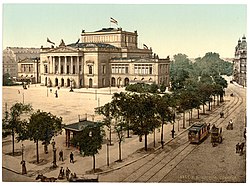| Revision as of 15:52, 5 June 2005 editHalibutt (talk | contribs)Autopatrolled, Extended confirmed users, Pending changes reviewers34,067 edits cross-naming in accordance with the Talk:Gdansk/Vote← Previous edit | Revision as of 17:54, 5 June 2005 edit undoMackensen (talk | contribs)Autopatrolled, Administrators125,175 editsm Reverted edits by Halibutt to last version by 194.25.104.253Next edit → | ||
| Line 13: | Line 13: | ||
| ]]] | ]]] | ||
| Having been a terminal of the first German long distance ] (], to ] |
Having been a terminal of the first German long distance ] (], to ], the capital of Saxony), Leipzig became a hub of Central-European railroad traffic, with a renowned station building, now the largest passenger train station in Europe. | ||
| The first German ], the ] (in German ''Allgemeiner Deutscher Arbeiterverein'', ADAV) was founded in Leipzig on ] ] by ]; about 600 workers from across Germany travelled to it using the new railway line. | The first German ], the ] (in German ''Allgemeiner Deutscher Arbeiterverein'', ADAV) was founded in Leipzig on ] ] by ]; about 600 workers from across Germany travelled to it using the new railway line. | ||
Revision as of 17:54, 5 June 2005
Leipzig (Polish; Sorbian/Lusatian: Lipsk) is the largest city in the federal state (Bundesland) of Saxony in Germany. The name is derived from the Slavic word (see Sorbian) Lipsk (settlement where the linden trees stand). It is situated at the confluence of the rivers Pleiße, White Elster and Parthe. Leipzig's population, which peaked at 750,000 before the second world war, has diminished to just about 500,000 by 2002.
History
First documented in 1015 (originally a Slavic settlement), and endowed with city and market privileges in 1165, Leipzig has always been known as a place of commerce. The Leipzig Trade Fair became an event of international importance; especially as a point of contact to the East-European economic bloc (Comecon) of which East Germany was a member.
The foundation of the University of Leipzig in 1409 initiated the city's development into a center of the publishing industry, and towards being a location of the German National Library (founded in 1912). Johann Sebastian Bach worked in Leipzig from 1723 to 1750, at the St. Thomas church. In 1813, the Leipzig region was the arena of the Battle of the Nations. In 1913 a monument, the Völkerschlachtdenkmal, celebrating this event was finished.

Having been a terminal of the first German long distance railroad (1838, to Dresden, the capital of Saxony), Leipzig became a hub of Central-European railroad traffic, with a renowned station building, now the largest passenger train station in Europe.
The first German labour party, the General German Workers' Association (in German Allgemeiner Deutscher Arbeiterverein, ADAV) was founded in Leipzig on 23 May 1863 by Ferdinand Lassalle; about 600 workers from across Germany travelled to it using the new railway line.
Nobel prize laureate Werner Heisenberg worked as a physics professor at Leipzig University from 1927 to 1942.

On November 9, 1938, on a night now known as Kristallnacht, Nazis in Leipzig destroyed Jewish synagogues and establishments in Leipzig as they did all over Germany. A U.S official in Leipzig described what he saw of the atrocities. "Having demolished dwellings and hurled most of the moveable effects to the streets," he wrote, "the insatiably sadistic perpetrators threw many of the trembling inmates into a small stream that flows through the zoological park, commanding horrified spectators to spit at them, defile them with mud and jeer at their plight."
The city was heavily damaged by Allied bombing during World War II.
American troops of the 69th Infantry Division captured the city on April 20 1945, Adolf Hitler's 56th and final birthday. The US later ceded the city to the Red Army, and it was one of the major cities of East Germany.
In 1989 after prayers for peace at the Nikolai Church (established in 1983 as part of the peace-movement) the Monday demonstrations started as the most prominent mass event that led to democratisation and later on to the German reunification.
Leipzig was also the German candidate for the 2012 Summer Olympics, but didn't make it into the final list of bidders.
Quotations
Mein Leipzig lob' ich mir! Es ist ein klein Paris und bildet seine Leute. (I praise my Leipzig! It is a small Paris and educates its people.) -- Johann Wolfgang von Goethe in Faust
Buildings
Twinning
Leipzig is twinned with Birmingham, England and Houston, Texas.
Sights
Among Leipzig's noteworthy institutions are also the Gewandhaus Orchestra, the opera house, Oper Leipzig, and the Leipzig Zoo, which houses the world's largest facilities for primates. Additionaly Leipzig has an international trade fair ground in the north of the city with the world largest levitated Glass Hall. (Leipzig Trade Fair)
Events
- Literature expostition & festival (March): http://www.leipziger-buchmesse.de/
- The Johann Sebastian Bach Festival (May): http://www.bach-leipzig.de/
- International Dark, Wave, Gothic Festival (Whitsun): Wave_Gotik_Treffen
- Emancipatoric Punk & Electro Festival (August): http://www.ladyfestleipzig.de/
- International Documentary and Animated Film Festival (October): http://www.dokfestival-leipzig.de/homepage/en/
- French Film Festival (October): http://www.franzoesische-filmtage.de/
- Leipzig Jazz Festival (November): http://www.leipziger-jazztage.de/
- Contemporary European Theater Festival (November): http://www.leipzig-online.de/euro-scene/
- Games Convention, computer- and videogames fair for customers: http://www.gc-germany.de/gcinfo_e.shtml
Culture
- Sprachenabend: International languages nights: http://www.leipzig.sprachenabend.de/
- Tangofabrik: Tango, Jazz in Fusion: http://www.tangofabrik-leipzig.de/
- Moritzbastei: Concerts, Lectures, Theater, Café, Students: http://www.moritzbastei.de/
- Conne Island: Emancipatoric Rock, Punk, Ska, Electro: http://www.conne-island.de
External links
- The city's official website: http://www.leipzig.de
- The city's trade fair: Leipzig Trade Fair
- Independent news weblog: http://www.leipzig-blog.de
- Stay for free with friendly Leipzig inhabitants: Hospitality Club Leipzig
- Images and impressions in different languages: augenblicke :: A photoblog from Leipzig